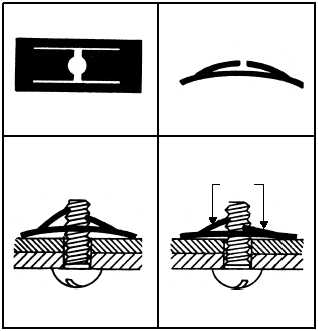The elastic stop nut is constructed with a
nonmetallic (nylon) insert, which is designed to lock
the nut in place. The insert is unthreaded and has a
smaller diameter than the inside diameter of the nut.
Self-locking nuts are generally suitable for reuse in
noncritical applications provided the threads have not
been damaged. If the locking material has not been
damaged or permanently distorted, it can be reused.
NOTE: If any doubt exists about the condition of a
nut, use a new one!
When you anchor lightweight parts, the sheet
spring nut may be used. See figure 5-8. Applications
include supporting line clamps, electrical equipment,
and small access doors. It is made of sheet spring steel
and is cut so as to have two flaps. The ends of these
flaps are notched to form a hole that is somewhat
smaller in diameter than the screw used. The sheet
spring nut has a definite arch that tends to flatten out as
the screw pulls the flaps in toward the threads. This
flattening action forces the flaps of the nut tightly into
the threads of the screw. The springiness of the sheet
spring nut pushes upward on the screw threads, binding
them and locking the screw in place. With the sheet
spring nut, either a standard or a sheet metal
self-tapping screw is used.
INSTALLATION OF NUTS AND BOLTS
You must be certain that each bolt is made of the
correct material. Examine the markings on the head to
determine whether a bolt is steel or aluminum alloy.
It is of extreme importance to use like bolts in
replacement. In every case, refer to the applicable
maintenance instruction manual and illustrated parts
breakdown.
Be sure that washers are used under the heads of
both bolts and nuts unless their omission is specified. A
washer guards against mechanical damage to the
material being bolted and prevents corrosion of the
structural members. An aluminum alloy washer may be
used under the head and nut of a steel bolt securing
aluminum
alloy
or
magnesium
alloy
members.
Corrosion will attack the washer rather than the
members. Steel washers should be used when joining
steel members with steel bolts.
Whenever possible, the bolt should be placed with
the head on top or in the forward position. This
positioning helps prevent the bolt from slipping out if
the nut is accidentally lost.
Make sure that the bolt grip length is correct.
Generally speaking, the grip length should equal the
thickness of the material being bolted together. Not
more than one thread should bear on the material, and
the shank should not protrude too far through the nut.
Figure 5-2 shows examples of correct and incorrect grip
length.
Application of Torque
Torque is the amount of twisting force applied
when you are tightening a nut. If torque values are
specified in the appropriate manual, a torque wrench
must be used. Regardless of whether torque values are
specified or not, all nuts in a particular installation must
be tightened a like amount. This permits each bolt in a
group to carry its share of the load. It is a good practice
to use a torque wrench in all applications.
Safetying of Nuts and Bolts
It is very important that all nuts except the
self-locking type be safetied after installation. This
prevents nuts from loosening in flight because of
vibration. Methods of safetying are discussed later in
this chapter.
Q5-2.
What are the three principal parts of a bolt?
Q5-3.
What are the three most commonly used
screws in aircraft construction?
Q5-4.
What general group of aircraft nuts require
an external locking device, such as cotter
pins, safety wire, or locknuts?
5-6
ANF0508
TOP VIEW
SIDE VIEW
STARTING POSITION
DOUBLE-LOCKED
POSITION
INWARD
THREAD
LOCK
A
B
C
D
Figure 5-8.—Sheet spring nut.



